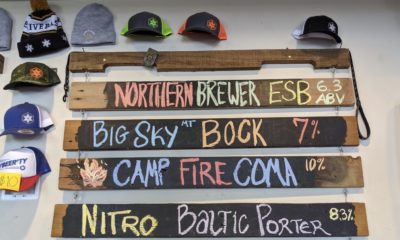Uncategorized
How to brew beer in the “End of Days”
Published
11 years agoon
Posted By
Outlaw PartnersBy Tyler Allen Explorebigsky.com Staff Writer
BIG SKY – Beer has perhaps the longest tradition of any alcoholic beverage and today is the world’s most widely consumed. Some even believe it ushered in our modern, agricultural civilization.
Whether beer actually came before bread, the first evidence of the beverage dates back to 9500 B.C. The ancient Egyptians consumed more beer than they did water – it was safer because fermented beverages are essentially sterile – and workers in that society were paid in beer rations.
Lone Peak Brewery is continuing this tradition with its “End of Days IPA,” brewed fresh this November.
While the tools and means for brewing have evolved since ancient times, the process has changed little. Adding yeast to grains (primarily barley, like the first brewers) and water creates fermentation. The yeast eats the sugars of the grains and the bi-products are alcohol and carbonation.
The addition of hops as a flavoring agent and preservative came much later, probably beginning in ninth century Europe. Today, most beers are flavored with hops, especially the big American India Pale Ales gaining popularity in this country. LPB’s “End of Days” belongs squarely in that category.
Due out the second week of December, LPB brewed this 2012 holiday IPA with American hops and pale malt from Great Falls, Mont., and then fermented it with American yeast.
This is the first time LPB has used American yeast, said Assistant Brewer Ben Smith. “We’ve always used English in the past. American [yeast] gives the beer a cleaner profile, lets the hops shine more.”
Creating the modern refreshment that will be poured in the tap room all starts with a recipe and a little creativity.
“Every style of beer has a traditional recipe and then you tweak it,” said Smith, who helped Head Brewer Ian Hendry conceptualize the recipe. “It’s like every good cook has a beef stew recipe, but everyone’s is different.”
The work began on Nov. 19. First, the tanks, hoses, fittings and anything else that might come in contact with the beer were sanitized. This prevents any unwanted bacteria or yeasts from jeopardizing the fermentation process.
In the basement below LPB’s tasting room, the brewers added the malted barley to the hopper, where an auger pushed it up into the mash tun – a big, silver tank – on the brewery floor. Here, they created the “mash” or “wort” by adding water and heat.
“If you mess up this process, you’re screwed,” said Hendry. They were shooting for a rate of 1.2 quarts of water per pound of grain, and a constant temperature of 154 degrees as the grain and water swirled together. At that temperature, the enzymes in the grains break down the carbohydrates into simple sugars, the feast for yeast.
“We’re looking for the consistency of mushy porridge,” Hendry said, as the brown slurry sloshed around the mash tun. “It’s like steeping tea. You want it cool enough not to extract any tannins [from the grain], but hot enough to break down any sugars.” Tannins are found in the husks of the grains and can give beer a bitter flavor and hazy look, he said.
Once all the grain was converted to mash, they let the mixture sit for an hour, allowing the enzymes to continue breaking down the sugars. Next they moved it into the kettle with a pump, which sends water into the mash tun. Called “sparging” or “lautering,” this adds more water to the mixture and also rinses the remaining sugars into the kettle.
Hendry and Smith then boiled the wort and added the first hops, an hour-long process that infuses the beer with its flavors. For additional aroma and flavor, they will add dry hops during fermentation, four to six days before carbonation and packaging.
After the boil, the beer should be cooled quickly to limit contaminants, Hendry explained. To do this, they pushed it through a heat exchanger, bringing it down to 68 degrees, which is the optimal temperature for fermenting ales. Once cooled, they piped it into the fermenting tanks, where the yeast does its magic for eight to 12 days.
Finally, the beer will be transferred to the “bright” tanks, where it’s cooled to 32 degrees and the yeast drops, or “flocculates,” to the bottom. The brewers will pull it off the yeast, strain it through a cloth and put it under pressure while adding carbon dioxide, giving it those enjoyable, belchable bubbles, before packaging in kegs or bottles.
“End of Days IPA” was named in honor of the Mayan calendar due to end Dec. 21, 2012. If we are in fact toasting to the final days here on Earth, there’s no better way than with one of our oldest libations.
The Outlaw Partners is a creative marketing, media and events company based in Big Sky, Montana.


Upcoming Events
april, 2024
Event Type :
All
All
Arts
Education
Music
Other
Sports
Event Details
Children turning 5 on or before 9/10/2024:
more
Event Details
Children turning 5 on or before
9/10/2024: Kindergarten
enrollment for the 2024-2025 school year can be completed by following the
registration process now.
Children
born on or after September 11, 2019: 4K enrollment is now open for
families that have a 4-year-old they would like to enroll in our program for
the 2023-2024 school year. Please complete the 4K Interest Form to
express your interest. Completing this form does not guarantee enrollment into
the 4K program. Enrollment is capped at twenty 4-year-olds currently
residing within Big Sky School District boundary full time and will be
determined by birth date in calendar order of those born on or after September
11, 2018. Interest form closes on May 30th.
Enrollment now is critical for fall preparations. Thank you!
Time
February 26 (Monday) - April 21 (Sunday)
Event Details
Saturday, March 23rd 6:00-8:00pm We will combine the heart-opening powers of cacao with the transcendental powers of breathwork and sound. Together, these practices will give us the opportunity for a deep
more
Event Details
Saturday, March 23rd 6:00-8:00pm
Time
March 23 (Saturday) 6:00 pm - April 23 (Tuesday) 8:00 pm
Location
Santosha Wellness Center
169 Snowy Mountain Circle
Event Details
We all are familiar with using a limited palette, but do you use one? Do you know how to use a
more
Event Details
We all are familiar with using a limited palette, but do you use one? Do you know how to use a limited palette to create different color combinations? Are you tired of carrying around 15-20 different tubes when you paint plein air? Have you ever wanted to create a certain “mood” in a painting but failed? Do you create a lot of mud? Do you struggle to achieve color harmony? All these problems are addressed in John’s workbook in clear and concise language!
Based on the bestselling “Limited Palatte, Unlimited Color” workbook written by John Pototschnik, the workshop is run by Maggie Shane and Annie McCoy, accomplished landscape (acrylic) and plein air (oil) artists,exhibitors at the Big Sky Artists’ Studio & Gallery and members of the Big Sky Artists Collective.
Each student will receive a copy of “Limited Palette, Unlimited Color” to keep and take home to continue your limited palette journey. We will show you how to use the color wheel and mix your own clean mixtures to successfully create a mood for your paintings.
Each day, we will create a different limited palette color chart and paint a version of a simple landscape using John’s directives. You will then be able to go home and paint more schemes using the book for guidance.
Workshop is open to painters (oil or acrylic) of any level although students must have some basic knowledge of the medium he or she uses. Students will be provided the book ($92 value), color wheel, value scale and canvas papers to complete the daily exercises.
Sundays, April 14, 21 and 28, 2024
Noon until 6PM.
$170.
Time
14 (Sunday) 12:00 pm - 28 (Sunday) 6:00 pm
Event Details
Everyone is invited to join us in celebrating 2 years of arts education in the BASE Art Studio with us! Take a tour
Event Details
Everyone is invited to join us in celebrating 2 years of arts education in the BASE Art Studio with us! Take a tour of the studio, meet our instructors, and meet other artists of all levels in our community. We’ll be getting creative and you’ll have the chance to make your very own artful button pin.
Stick around for our Volunteer Appreciation and Social beginning at 6:30 p.m.!
Time
(Thursday) 5:30 pm - 6:30 pm
Location
BASE
285 Simkins Dr










